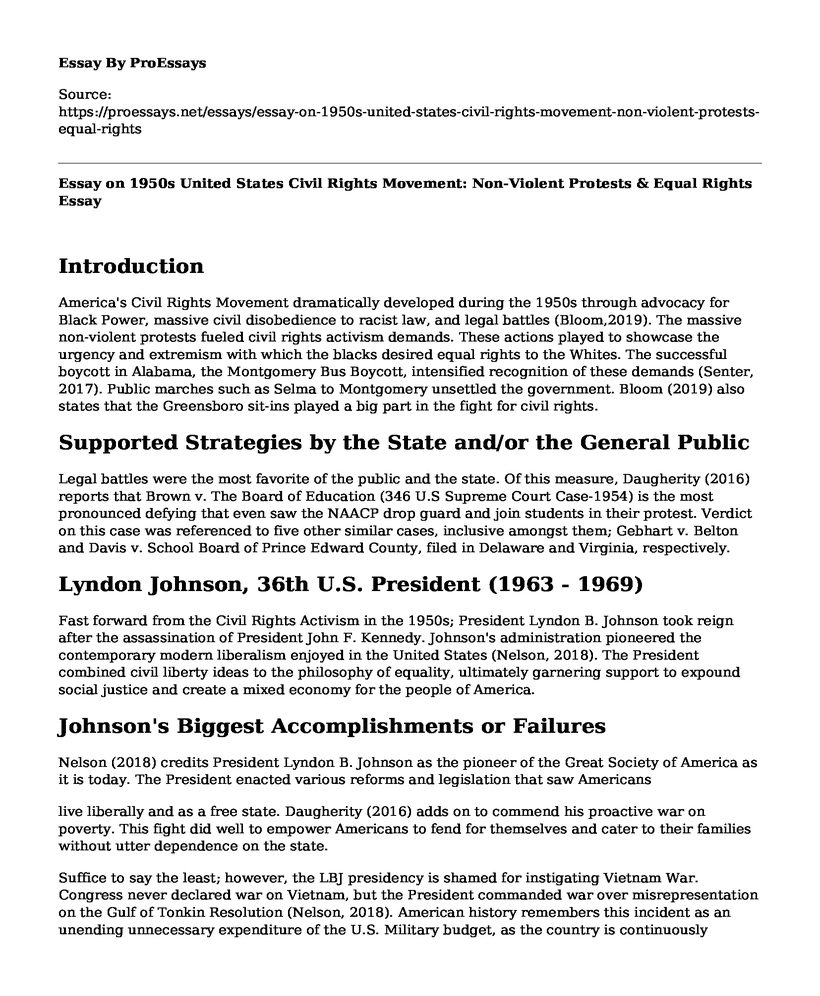Introduction
America's Civil Rights Movement dramatically developed during the 1950s through advocacy for Black Power, massive civil disobedience to racist law, and legal battles (Bloom,2019). The massive non-violent protests fueled civil rights activism demands. These actions played to showcase the urgency and extremism with which the blacks desired equal rights to the Whites. The successful boycott in Alabama, the Montgomery Bus Boycott, intensified recognition of these demands (Senter, 2017). Public marches such as Selma to Montgomery unsettled the government. Bloom (2019) also states that the Greensboro sit-ins played a big part in the fight for civil rights.
Supported Strategies by the State and/or the General Public
Legal battles were the most favorite of the public and the state. Of this measure, Daugherity (2016) reports that Brown v. The Board of Education (346 U.S Supreme Court Case-1954) is the most pronounced defying that even saw the NAACP drop guard and join students in their protest. Verdict on this case was referenced to five other similar cases, inclusive amongst them; Gebhart v. Belton and Davis v. School Board of Prince Edward County, filed in Delaware and Virginia, respectively.
Lyndon Johnson, 36th U.S. President (1963 - 1969)
Fast forward from the Civil Rights Activism in the 1950s; President Lyndon B. Johnson took reign after the assassination of President John F. Kennedy. Johnson's administration pioneered the contemporary modern liberalism enjoyed in the United States (Nelson, 2018). The President combined civil liberty ideas to the philosophy of equality, ultimately garnering support to expound social justice and create a mixed economy for the people of America.
Johnson's Biggest Accomplishments or Failures
Nelson (2018) credits President Lyndon B. Johnson as the pioneer of the Great Society of America as it is today. The President enacted various reforms and legislation that saw Americans
live liberally and as a free state. Daugherity (2016) adds on to commend his proactive war on poverty. This fight did well to empower Americans to fend for themselves and cater to their families without utter dependence on the state.
Suffice to say the least; however, the LBJ presidency is shamed for instigating Vietnam War. Congress never declared war on Vietnam, but the President commanded war over misrepresentation on the Gulf of Tonkin Resolution (Nelson, 2018). American history remembers this incident as an unending unnecessary expenditure of the U.S. Military budget, as the country is continuously funding a war that should not have started.
References
Bloom, J. M. (2019). Class, race, and the civil rights movement. Indiana University Press.
Daugherity, B. J. (2016). Keep on keeping on: The NAACP and the implementation of Brown v. Board of Education in Virginia. University of Virginia Press.
Nelson, M. (2018). The historical presidency: lost confidence: the Democratic Party, the Vietnam War, and the 1968 election. Presidential Studies Quarterly, 48(3), 570-585.
Senter, J. C. (2017). Martin Luther King Jr.: Fulfilling a Dream. Cavendish Square Publishing, LLC.
Cite this page
Essay on 1950s United States Civil Rights Movement: Non-Violent Protests & Equal Rights. (2023, Apr 08). Retrieved from https://proessays.net/essays/essay-on-1950s-united-states-civil-rights-movement-non-violent-protests-equal-rights
If you are the original author of this essay and no longer wish to have it published on the ProEssays website, please click below to request its removal:
- Does Society Have Different Expectations for Boys Then for Girls? Essay
- Essay Sample on Explaining the Beliefs Among Different Societies Regarding Mental Illness
- Current Events Which Are Happening in Line With the 8th Amendment in the USA
- Essay Sample on Newdow v. Elk Grove: An Establishment Clause Test Case
- Essay Example on Driven Communication Style: Taking Control to Lead Conversations
- Essay on U.S. Incarceration: Rising Crime, War on Drugs, and Shifting Attitudes
- Essay Example on Inmate Litigation & Prison Litigation Reform Act: Debunking Protection for Prisoners







